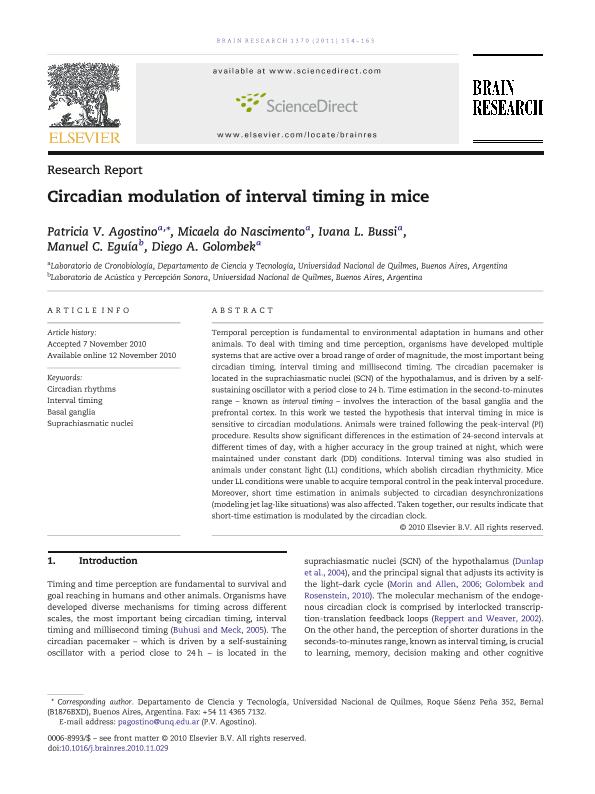Mostrar el registro sencillo del ítem
dc.contributor.author
Agostino, Patricia

dc.contributor.author
Do Nascimento, Micaela

dc.contributor.author
Bussi, Ivana Leda

dc.contributor.author
Eguia, Manuel Camilo

dc.contributor.author
Golombek, Diego Andres

dc.date.available
2023-03-23T15:48:50Z
dc.date.issued
2011-10
dc.identifier.citation
Agostino, Patricia; Do Nascimento, Micaela; Bussi, Ivana Leda; Eguia, Manuel Camilo; Golombek, Diego Andres; Circadian modulation of interval timing in mice; Elsevier Science; Brain Research; 1370; 10-2011; 154-163
dc.identifier.issn
0006-8993
dc.identifier.uri
http://hdl.handle.net/11336/191622
dc.description.abstract
Temporal perception is fundamental to environmental adaptation in humans and other animals. To deal with timing and time perception, organisms have developed multiple systems that are active over a broad range of order of magnitude, the most important being circadian timing, interval timing and millisecond timing. The circadian pacemaker is located in the suprachiasmatic nuclei (SCN) of the hypothalamus, and is driven by a self-sustaining oscillator with a period close to 24 h. Time estimation in the second-to-minutes range - known as interval timing - involves the interaction of the basal ganglia and the prefrontal cortex. In this work we tested the hypothesis that interval timing in mice is sensitive to circadian modulations. Animals were trained following the peak-interval (PI) procedure. Results show significant differences in the estimation of 24-second intervals at different times of day, with a higher accuracy in the group trained at night, which were maintained under constant dark (DD) conditions. Interval timing was also studied in animals under constant light (LL) conditions, which abolish circadian rhythmicity. Mice under LL conditions were unable to acquire temporal control in the peak interval procedure. Moreover, short time estimation in animals subjected to circadian desynchronizations (modeling jet lag-like situations) was also affected. Taken together, our results indicate that short-time estimation is modulated by the circadian clock.
dc.format
application/pdf
dc.language.iso
eng
dc.publisher
Elsevier Science

dc.rights
info:eu-repo/semantics/openAccess
dc.rights.uri
https://creativecommons.org/licenses/by-nc-sa/2.5/ar/
dc.subject
BASAL GANGLIA
dc.subject
CIRCADIAN RHYTHMS
dc.subject
INTERVAL TIMING
dc.subject
SUPRACHIASMATIC NUCLEI
dc.subject.classification
Biología

dc.subject.classification
Ciencias Biológicas

dc.subject.classification
CIENCIAS NATURALES Y EXACTAS

dc.title
Circadian modulation of interval timing in mice
dc.type
info:eu-repo/semantics/article
dc.type
info:ar-repo/semantics/artículo
dc.type
info:eu-repo/semantics/publishedVersion
dc.date.updated
2023-03-23T12:29:01Z
dc.journal.volume
1370
dc.journal.pagination
154-163
dc.journal.pais
Países Bajos

dc.journal.ciudad
Amsterdam
dc.description.fil
Fil: Agostino, Patricia. Universidad Nacional de Quilmes. Departamento de Ciencia y Tecnología. Laboratorio de Cronobiología; Argentina. Consejo Nacional de Investigaciones Científicas y Técnicas; Argentina
dc.description.fil
Fil: Do Nascimento, Micaela. Universidad Nacional de Quilmes. Departamento de Ciencia y Tecnología. Laboratorio de Cronobiología; Argentina. Consejo Nacional de Investigaciones Científicas y Técnicas; Argentina
dc.description.fil
Fil: Bussi, Ivana Leda. Universidad Nacional de Quilmes. Departamento de Ciencia y Tecnología. Laboratorio de Cronobiología; Argentina. Consejo Nacional de Investigaciones Científicas y Técnicas; Argentina
dc.description.fil
Fil: Eguia, Manuel Camilo. Consejo Nacional de Investigaciones Científicas y Técnicas; Argentina. Universidad Nacional de Quilmes. Departamento de Ciencia y Tecnología. Laboratorio de Acústica y Percepción Sonora; Argentina
dc.description.fil
Fil: Golombek, Diego Andres. Universidad Nacional de Quilmes. Departamento de Ciencia y Tecnología. Laboratorio de Cronobiología; Argentina. Consejo Nacional de Investigaciones Científicas y Técnicas; Argentina
dc.journal.title
Brain Research

dc.relation.alternativeid
info:eu-repo/semantics/altIdentifier/url/https://www.sciencedirect.com/science/article/pii/S0006899310025424
dc.relation.alternativeid
info:eu-repo/semantics/altIdentifier/doi/http://dx.doi.org/10.1016/j.brainres.2010.11.029
Archivos asociados
